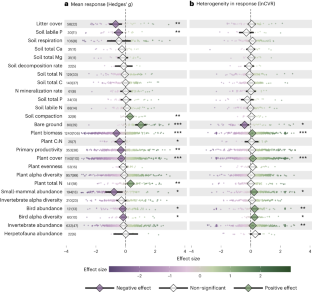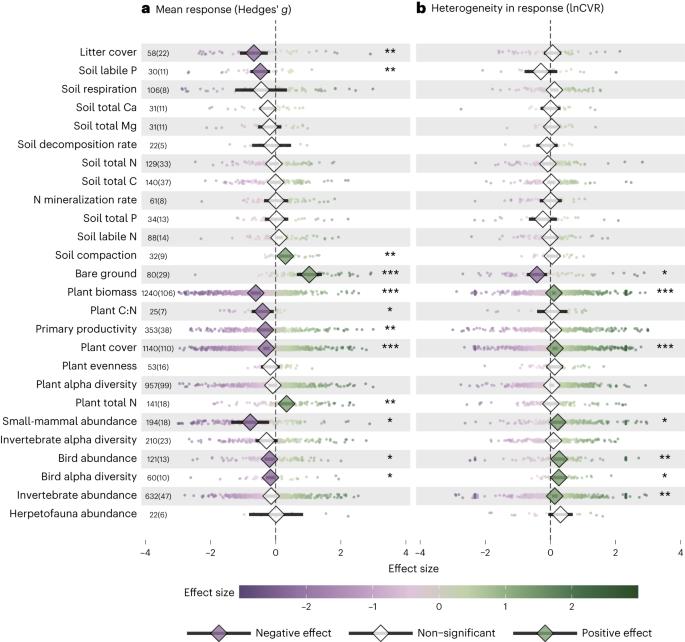元分析表明,野生大型食草动物塑造了生态系统的属性,并促进了空间异质性。
IF 13.9
1区 生物学
Q1 ECOLOGY
引用次数: 0
摘要
巨型动物(体重≥45 千克的动物)可能已经塑造了地球陆地生态系统数百万年,对生物地球化学、植被、生态群落和进化过程产生了明显的影响。然而,关于巨型动物对生态系统影响的普遍性,目前还缺乏定量的全球综合研究。在此,我们对横跨六大洲的 297 项研究和 5,990 个观测数据进行了荟萃分析,以确定野生食草巨型动物如何影响生态系统结构、生态过程和空间异质性,以及这些影响是否取决于体型和环境因素。尽管巨型动物的影响存在很大差异,但我们发现巨型动物显著改变了土壤养分的可用性,促进了开阔的植被结构,并减少了小型动物的数量。其他反应(26 项反应中的 14 项),包括土壤碳等,并未受到明显影响。此外,巨型动物通过影响植被结构的空间异质性以及小型动物的数量和多样性,大大增加了生态系统的异质性。鉴于空间异质性被认为是跨分类群和跨尺度生物多样性的重要驱动因素,这些结果支持了巨型动物可能在大尺度上促进生物多样性的假设。自更新世晚期以来,巨型动物的多样性和数量急剧下降,我们的研究结果表明,恢复巨型动物将对地球陆地生态系统产生重大影响。本文章由计算机程序翻译,如有差异,请以英文原文为准。


Meta-analysis shows that wild large herbivores shape ecosystem properties and promote spatial heterogeneity
Megafauna (animals ≥45 kg) have probably shaped the Earth’s terrestrial ecosystems for millions of years with pronounced impacts on biogeochemistry, vegetation, ecological communities and evolutionary processes. However, a quantitative global synthesis on the generality of megafauna effects on ecosystems is lacking. Here we conducted a meta-analysis of 297 studies and 5,990 individual observations across six continents to determine how wild herbivorous megafauna influence ecosystem structure, ecological processes and spatial heterogeneity, and whether these impacts depend on body size and environmental factors. Despite large variability in megafauna effects, we show that megafauna significantly alter soil nutrient availability, promote open vegetation structure and reduce the abundance of smaller animals. Other responses (14 out of 26), including, for example, soil carbon, were not significantly affected. Further, megafauna significantly increase ecosystem heterogeneity by affecting spatial heterogeneity in vegetation structure and the abundance and diversity of smaller animals. Given that spatial heterogeneity is considered an important driver of biodiversity across taxonomic groups and scales, these results support the hypothesis that megafauna may promote biodiversity at large scales. Megafauna declined precipitously in diversity and abundance since the late Pleistocene, and our results indicate that their restoration would substantially influence Earth’s terrestrial ecosystems. A meta-analysis synthesizes the range of effects of megafauna on ecosystems, finding that megafauna significantly increase ecosystem heterogeneity and impact a wide range of ecosystem properties by altering soil nutrient availability, promoting open vegetation structure and reducing the abundance of smaller animals.
求助全文
通过发布文献求助,成功后即可免费获取论文全文。
去求助
来源期刊

Nature ecology & evolution
Agricultural and Biological Sciences-Ecology, Evolution, Behavior and Systematics
CiteScore
22.20
自引率
2.40%
发文量
282
期刊介绍:
Nature Ecology & Evolution is interested in the full spectrum of ecological and evolutionary biology, encompassing approaches at the molecular, organismal, population, community and ecosystem levels, as well as relevant parts of the social sciences. Nature Ecology & Evolution provides a place where all researchers and policymakers interested in all aspects of life's diversity can come together to learn about the most accomplished and significant advances in the field and to discuss topical issues. An online-only monthly journal, our broad scope ensures that the research published reaches the widest possible audience of scientists.
 求助内容:
求助内容: 应助结果提醒方式:
应助结果提醒方式:


